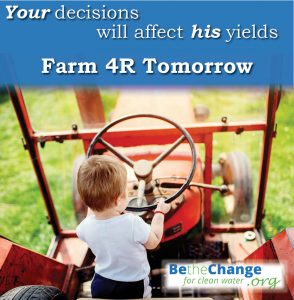
Farming’s not easy. Weather, fluctuating trade policies, fuel costs, stringent standards on grains delivered to market, changing consumer tastes, and the regulatory environment all contribute to uncertainty and unforeseen costs. And most of these variables are impossible to control. But, you can control what IS in your “sphere of influence,” which includes nutrient stewardship on the farm.
Improve your bottom line by practicing the 4 Rs. Use the right source at the right rate, at the right time, with the right placement. Consult the Tri-state Fertilizer Recommendations and your 4R Certified Crop Advisor before applying nutrients. Check this map to find your nearest 4R Certified Facility.
For many of us, the first thought that comes to mind is the old “School Days” tune and the golden rule of learning reading, ‘riting, ‘rithmetic, and (everyone’s favorite) recess. While no doubt these things were all important to us as kids, the golden rule for agriculture today is the 4Rs of nutrient stewardship: Right fertilizer source at the Right rate at the Right time and in the Right place.

Properly managed fertilizers support agricultural systems that provide economic, social, and environmental benefits. Poorly managed nutrient applications waste time and money while increasing nutrient losses, potentially degrading water and air.
4R nutrient stewardship requires the implementation of Best Management Practices (BMPs) that optimize the efficiency of fertilizer use. The goal of fertilizer BMPs is to balance the amount of fertilizer added with crop requirements and to minimize nutrient losses from fields. The selection of BMPs varies by location, and those chosen for a given site are dependent on local soil and climatic conditions, crop management conditions, and other site-specific factors. Soil tests take the guesswork out of buying fertilizers, chemicals, and other soil amendments.
Other agronomic and conservation practices, such as no-till farming, cover crops, buffer strips, and crop rotation play a valuable role in supporting 4R nutrient stewardship. As a result, fertilizer BMPs are most effective when applied in conjunction with other agronomic and conservation practices. Combining these practices not only fosters nutrient stewardship but can increase yields and improve soil health and resiliency in the long term. Learn more about 4R nutrient stewardship, watch a short video from The Nature Conservancy, or visit our office or the Natural Resources Conservation Service office. We’re co-located in the same building.
